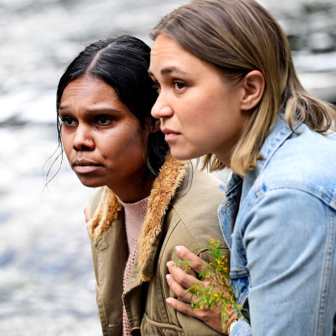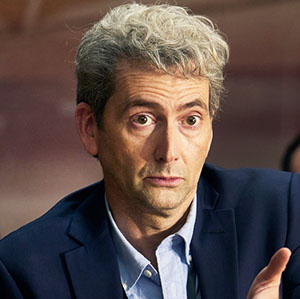A solitary vehicle speeds across a horizontal landscape, tracking off-road onto the swampy ground of a delta at low tide. This is the Dampier Peninsula, where the waters of a vast river system lap at the edges of desert country, and this is the opening of season two of Mystery Road.
In the mangrove swamps that harbour crab colonies, a lone fisherman has found another kind of catch: a headless body. The lurking crocodiles are not the only predators claiming territory here because they, it seems, are not responsible for the decapitation.
Detective Jay Swan (Aaron Pedersen), sent from “down south” to investigate, arrives at nightfall. In the opening frames of the first episode, a low-angled shot, backlit by the tail-lights of his truck, gives us a close-up of boots hitting the ground as he walks to the crime scene in darkness.
This sequence echoes Swan’s arrival in season one, as if to remind us that whatever happens here will be discovered by those who tune in to the lie of the land. Nothing stays buried permanently, as archaeologist Sandra Elmquist (Sofia Helin) is determined to prove, though she unearths a lot more than she bargained for.
Swan’s presence stirs everything up — or rather, everyone. He interferes with established hierarchies at the police station, has a stand-off with a community lawman and clashes with the owner of a major trucking station outside the town. He also pays an unwanted visit to his ex-wife Mary (Tasma Walton), who hands him a box of his possessions and leaves him standing on the doorstep.
Given his propensity to do and say almost nothing during these confrontations, he’s an odd sort of catalyst, impervious to all the passions, convictions and determinations that drive people to do what they do. Jay Swan just wants to know what they’ve done; the strategies they use to prevent intervention, however ingenious, are irrelevant. So he stands there, feet firmly planted, arms in gun-ready position, watching for whatever might come up. Nothing unnerves him.
It takes some nerve for an actor to sustain the unvarying stance and monotone delivery, and draw instead on an inner authority in the character to sustain the confidence that the performance won’t fall flat. Australian television drama is so plagued with overblown sentiment (Stateless being a recent culprit) that I wish there were an Aaron Pedersen school of acting.
In interviews, Pedersen talks about maintaining “the framework of the character” over the seven years since Ivan Sen made the original Mystery Road feature film. This, rather than the display of emotion, is the television actor’s job. Everyone is to some degree an enigma in a good crime series, and no one more so than the detective at the centre of it. There are mystery roads in everyone.
Pedersen’s command of this stoic principle invites comparison with Sofia Helin’s compelling performance as Saga, the detective with Asperger’s syndrome in The Bridge. The scenes between the two of them in Mystery Road are brief but create a meeting point between two wonderfully nuanced interpreters of human communication.
The storyline surrounding Helin’s character, an archaeology professor from a Swedish university, adds a new edge to cultural tensions already in play among the Indigenous community of Gideon, the small town where the murders are taking place. Obsessive and self-involved, she works at her dig site alone, continuing into the night hours to the accompaniment of “Laudate Dominum” played on a portable sound system. The music, along with the variety of spirituality it expresses, is an alien import.
Sandra’s overriding determination to find evidence of prehistoric Aboriginal technologies combines with an obtuseness towards the cultural life going on around her in the present. As the local people talk, sing, drink and quarrel, she literally has her head in the sand, desperate to resist any interference, including that of a roaming detective who might take an interest in some all-too-recent human remains.
Strong performances also come from Jada Alberts as the young local officer assigned to assist Swan in his enquiries and Stan Yarramunua as Jimmy Two, the self-appointed guardian of traditional law and lore. But as in season one, this is essentially an ensemble cast, again brought together by casting director Anousha Zarkesh. It is the mood and milieu of community life that gives the series its dynamic psychological texture.
Everything about the production communicates a sense of natural authority. There are no indulgences. The writing team has created a script that’s as dry as the land, relying on the inherent power of the story and setting to carry the impact. If emotions run high around here, it’s in ways that don’t communicate through dialogue. Fights are part of life.
So is music, and songs bring out emotional dimensions that are suppressed in the Spartan dialogue. In the evenings, the community gathers round the outdoor bar, bringing their quarrels with them, and listen to an array of live performers including the Saltwater Band and Fitzroy Xpress. Thematic keynotes are carried on the soundtrack, with abrasive renditions of “Rainmaker” and “Break the Silence” from Southeast Desert metal, “Rise Up” from Daphne Willis, and the haunting lyrics of RillaKill’s heavy metal “My Time Is Comin’” playing across the opening titles of each episode.
And then there is the cinematography. Warwick Thornton, who in collaboration with Wayne Blair also directs, has taken over the photographic direction from Mark Wareham (cinematographer for season one) and continues the visual romance with landscape and natural light. This place is stunningly beautiful, but also so vast and strange it dwarfs all human affairs, even the most extreme. In one scene, a man is being tortured and his scream as the ordeal ramps up is merged with the cry of birds; the scene cuts to an image of the flock rising high over the waters in deep twilight.
There are too many detective series on television. I weary of murder stories (even though I used to write the damn things myself), but every so often one with some real originality emerges. For its stringent scripting, its ensemble performance and its visual poetry, Mystery Road is in a class of its own in Australian television drama. •




